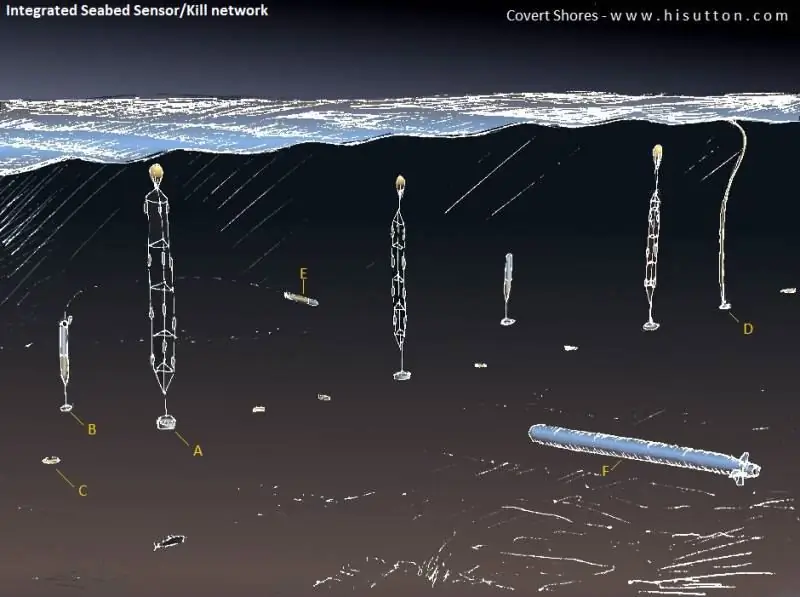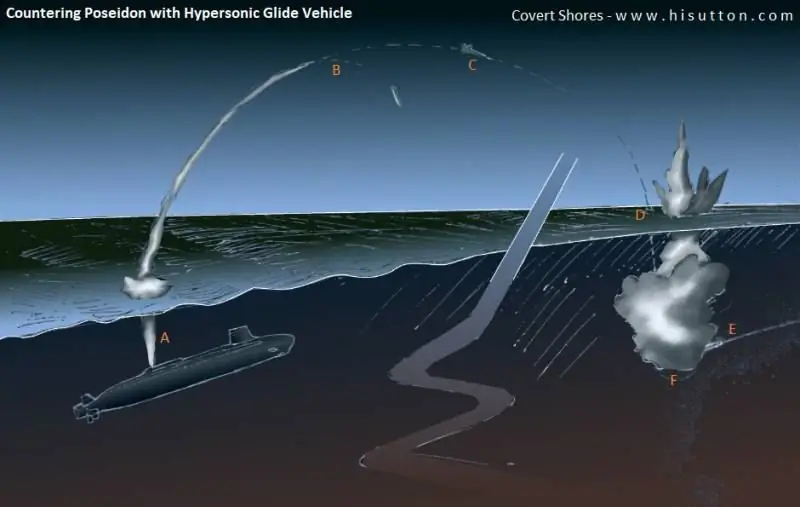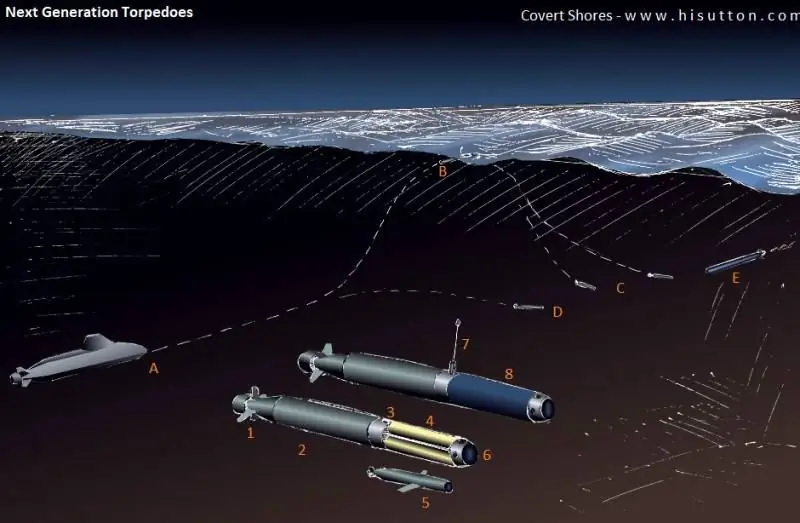- Author Matthew Elmers [email protected].
- Public 2023-12-16 21:49.
- Last modified 2025-01-24 09:17.
In March of this year, Russia for the first time officially presented information about a promising multipurpose oceanic system, later called Poseidon. The available data on this development has become a major concern. However, foreign experts were able to cope with the excitement and began to study the dangerous object. Among other things, work has begun on issues of countering Poseidon.
Perhaps the most complete material at the moment about the fight against a promising Russian model was presented by the American researcher of the submarine fleet H. I. Sutton. Not so long ago, on his own website Covert Shores, he published a voluminous article entitled "Killing KANYON: Countering new Russian Intercontinental Nuclear Torpedoes" - "Kill Kanyon: Countering Russia's new intercontinental nuclear torpedo." The topic of this material, as follows from its title, was the fight against the unusual weapons of Russia.
At the beginning of the article, the author notes that the promising product "Poseidon" (also known as "Status-6", Kanyon and "Skif") differs from existing submarines in greater speed and depth of movement, as a result of which it will have to be dealt with using new means. H. I. Sutton tried to determine what new types of weapons could be created in NATO to combat the unusual threat.

The alleged appearance of "Poseidon"
The author notes that the reasons for the appearance of "Poseidon" are not completely clear. The simplest assumption links this project to the development of missile defense. A modern missile defense system reduces the potential of intercontinental missiles, and this requires a restructuring of strategic nuclear forces. It is also possible that the new project was launched in connection with the Treaty on the Reduction of Offensive Arms. The new weapon is not subject to its effect, and therefore its deployment is limited only by certain other agreements of a very general nature. Finally, Project Poseidon could be based on the principle of increasing reliability. The special submarine does not depend on satellite navigation, and thanks to this, it can continue to work even if the space group is defeated.
H. I. Sutton believes that the reason for the emergence of the project could hardly have been the secrecy of the submarine. Poseidon is not a silent unmanned boat capable of invisibly entering the water area and launching the first strike without warning. He also notes that the new Russian development can be attributed to the class of unmanned vehicles, but in essence it is a weapon. Consequently, the modes of operation and routes of the apparatus will be as simple and reliable as possible. Moving along straight routes, Poseidon will rely not on stealth, but on speed and depth.
The author calls Poseidon a unique multipurpose weapon that can be used as a strategic or tactical delivery vehicle. In this respect, the product can be considered as a long-range torpedo with a special warhead. It can target coastal cities or moving surface objects.
In the demonstration videos, the Poseidon product was shown as a tactical nuclear weapon, which makes it especially important to counter it. The use of such a system for strategic purposes, in turn, is prevented by the threat of a retaliatory strike and mutually assured destruction. In these conditions, means of countering such weapons are not needed or can interfere, since one of the parties gains a certain advantage. Such arguments are often used in disputes over missile defense, and, perhaps, the Poseidon project was created precisely as a response to anti-missile systems.
If "Poseidon" was originally developed as a strategic weapon, then there are answers to some questions. With its help, despite the development of missile defense, the possibility of an effective retaliatory strike remains. At the same time, such a system can be used as a tactical nuclear weapon, which imposes different requirements for counteraction.
According to Kh. I. Sutton, two countries at once are directly interested in creating means of protection against Poseidon - these are the United States and Great Britain. Both of these states have developed naval forces, which may be the target of Russian vehicles in the role of tactical weapons. In addition, their fleets have hunting submarines, whose task is to search for Russian strategic missile carriers. In the future, they will have to master search and unmanned aerial vehicles.

The proposed version of the hydroacoustic complex. A - hydroacoustic search system; B - naval mine; C - Seatooth communication system; D - communication buoy; E - torpedo; F - product "Poseidon"
Beginning in the 1960s, Western hunting submarines were created to track Soviet ships carrying ballistic missiles. They had to be able to immediately attack and destroy their target, preventing the launch of the missiles. Such principles are still relevant, but their implementation is associated with certain problems. Russian submarines have become quieter, and NATO is increasingly facing a shortage of its submarines to patrol. Search and destruction of enemy submarines can be carried out using various autonomous systems, but in the case of the Poseidon, everything turns out to be much more complicated. Even if all the missile submarines were found and destroyed, NATO fleets will have to search for and hit autonomous vehicles, otherwise a great threat remains.
Seatooth-linked marine meshes
Before the attack, the underwater target should be found, and H. I. Sutton is considering the further development of anti-submarine search systems. He believes that the existing stationary hydroacoustic systems need special additions. The latter should be a rapidly deployable surveillance network. It may also include its own means of destruction. The presence of weapons will reduce the reaction time, which is critical in light of the high speed of the Poseidon.
Such nets should be placed along the intended path of the enemy's underwater vehicle. The author believes that an attempt to pursue and attack from the rear hemisphere may not be successful due to the high speed of the target. According to the known data, "Poseidon" will be able to develop a speed of about 70 knots, which is close to the maximum limit of torpedo-type objects.
For the rapid deployment of sonar systems, it is necessary to use patrol aircraft or anti-submarine helicopters. It is also necessary to work out the issue of creating a cruise missile with a cluster warhead that can accommodate the necessary instruments. Such a product will allow, in the shortest possible time, to establish a network of surveillance equipment, including in an area under enemy control, where aviation is excluded.
Usually, sonar buoys are used to search for submarines, which have radio communication with the aircraft / helicopter carrier or the shore. However, Poseidon's deep travel can render them useless. In this case, it is necessary to use bottom-mounted equipment. Such devices have an additional advantage over buoys: they do not drift, and therefore the network can work for a long time.
Modern seabed detection equipment has a characteristic drawback. The individual components of such networks are connected using cables - they increase the weight of the system, and in addition, are prone to unauthorized connections. These problems can be eliminated with modern wireless communication systems such as Seatooth from WFS Technologies. Such equipment at short distances can use acoustic communication, and with increasing range, radio is used. At minimum distances, optical communication is possible, providing the highest transmission rates. It is important that each Seatooth communication unit includes all three types of instruments.

Defeat Poseidon with hypersonic weapons. A - Virginia-class submarine with VPM module; B - point of separation of the accelerator; C - hypersonic glider vehicle; D - discharge of the payload into the water; E - Poseidon's trajectory; F - meeting the payload with the target
The interception system may include naval mines and special bottom torpedo tubes. They should be equipped with Seatooth instruments and integrated into the overall complex. This network design, as well as new principles for processing incoming information, among other things, could reduce the likelihood of false alarms. It also becomes possible to update the data in the torpedo equipment as it passes by new network nodes.
The placement of torpedo launchers along the sensor network should ensure the correct response to the Poseidon threat. Due to this, it will be possible to obtain the most serious advantages over stationary mines. Also, the network anti-submarine complex will be able to transmit data to the shore, which will allow attracting other funds to work.
Long range defeat
Vertical silo launchers found on many US submarines, according to H. I. Sutton, can be used to fire promising hypersonic glider missiles with one or another payload. So, such a weapon can be equipped with an anti-submarine torpedo or a special warhead, as a result of which it will become a modern analogue of the decommissioned UUM-44 SUBROC complex. The short flight time and long range of the glider will give the carrier submarine special capabilities. In fact, ships in the North Atlantic will be able to attack Poseidon in the Arctic Ocean. In this case, the warhead or torpedo will arrive in a new area before the unmanned vehicle leaves a great distance from the place of detection.
An alternative to hypersonic gliders can be “traditional” missiles or high-speed vehicles with ramjet engines. According to known data, the United States is currently developing several projects of this kind at once. Similar systems are being created abroad - China is leading the DF-ZF project, and in Russia a product "4202" or "Avangard" is being created. The author notes that the relatively large size of the first stage of a missile of this class will not allow it to be used as a carrier for a British submarine.
New generation torpedoes
The existing models of torpedo weapons used by the navies of the United States and Great Britain were created to combat submarines capable of developing relatively high speeds and diving to a sufficiently large depth. However, the available data on the Poseidon project shows that the characteristics of modern torpedoes may be insufficient to deal with promising threats. This means that to counter the new Russian development, it is necessary to create completely new torpedoes.

Promising torpedo armament. A - the submarine launches a torpedo; B - the torpedo rises to the surface to search for a target and receive target designation; C - dive torpedo; D - the torpedo is heading towards the target; E - the approaching vehicle "Poseidon"
A promising torpedo weapon, most likely, will differ little from unmanned underwater vehicles. It is to be expected that such weapons will be created in both light and heavy classes. Its caliber will reach 21 inches - 533 mm. The author suggests that a heavy torpedo, capable of carrying several samples of a light class or drones, is possible. Such equipment will increase the likelihood of successful target detection, and then simplify targeting and subsequent defeat.
Light torpedoes of the new type should be small in size, which will allow them to be placed inside a 21-inch carrier torpedo. The latter will be able to carry two torpedoes with a caliber of 10.5 inches (267 mm) or three 9.5-inches (228 mm). Thus, a promising light torpedo turns out to be significantly less than the existing serial products of its class, which are in service with NATO.
As a result, it becomes necessary to create a whole line of torpedo armament of three types. It should include a 533-mm torpedo for use by submarines, 324-mm ammunition for anti-submarine helicopters and surface ships, as well as 9.5-inch products for use with larger carrier torpedoes.
***
From the available information, it follows that the Poseidon ocean multipurpose system is a fundamentally new model of naval technology capable of solving various problems, primarily related to the defeat of various surface and coastal objects. The unique running characteristics of the product contribute to obtaining high combat qualities.
It is quite understandable why the Poseidon project attracted the attention of foreign experts. Even the limited amount of data available on this development shows how serious a threat it is. Naturally, immediately after the appearance of open information, foreign military and experts tried to determine the real capabilities and threats of the underwater vehicle, as well as find ways to counter it.
It should be noted that from the point of view of the technical appearance "Poseidon" is a cross between super-heavy torpedoes and nuclear submarines, and unites one or another of their qualities. The result is special technical characteristics, and with them outstanding capabilities of all kinds. The performance characteristics and the strategy of using a multipurpose system, in turn, turn out to be a serious challenge for foreign military personnel and designers.
Even a cursory study of the available data shows that Poseidon is able to overcome the resistance of at least part of modern anti-submarine systems without serious difficulty. To ensure the proper level of protection, promising means of detection and destruction with increased characteristics are needed. H. I. Sutton in his article "Killing KANYON: Countering new Russian Intercontinental Nuclear Torpedoes" considered the main problems and issues of creating such an interception system, and also made some suggestions.
The thoughts of a foreign author seem correct and logical. Indeed, the presence of stationary and rapidly deployable hydroacoustic networks, as well as the use of promising torpedoes and highly efficient control systems can reduce the threat of Poseidon. However, at the moment, all these funds are missing. Will they appear, and will NATO be able to effectively counter new challenges - time will tell. Russia has made its new project, and experts have commented on it. The next move in this game is for foreign military personnel and designers.






